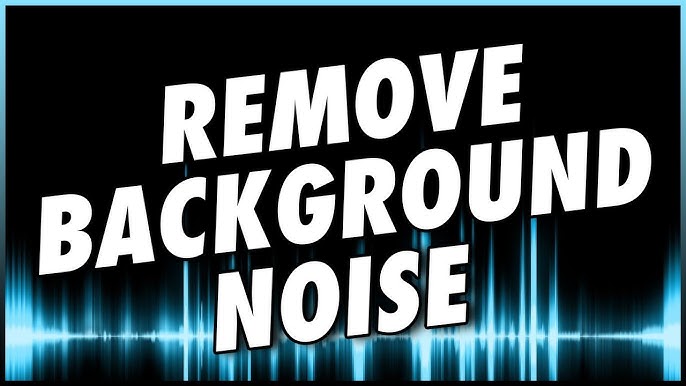In today’s content-driven world, high-quality audio is as important as stunning visuals. Whether you’re producing a YouTube video, a corporate presentation, or a podcast, background noise can detract from the professionalism of your content. Thankfully, there are effective methods to remove background noise from videos, ensuring your audio is clear and engaging. In this comprehensive guide, we’ll explore why background noise matters, the tools available for noise removal, and step-by-step methods to achieve pristine audio.
Understanding Background Noise
What is Background Noise?
Background noise refers to any unwanted sounds that are present in an audio recording. This can include ambient sounds, such as traffic, chatter, wind, or electronic hums, which can overshadow the primary audio, such as dialogue or music. In video production, background noise can distract viewers, making it difficult to focus on the content.
Why is It Important to Remove Background Noise?
- Enhances Clarity: Clear audio allows viewers to understand the content without straining to hear or decipher muffled sounds.
- Professionalism: High-quality audio is a hallmark of professional content. Poor audio quality can diminish the perceived value of your work.
- Improves Engagement: Audiences are more likely to engage with content that has clear, uninterrupted audio. Good audio quality keeps viewers focused and interested.
- Increases Accessibility: Clean audio is essential for accessibility. Those with hearing impairments will have an easier time following along when background noise is minimized.
Tools for Removing Background Noise
Before diving into the techniques for removing background noise, it’s essential to understand the tools you can use. There are several software options available that can help you achieve high-quality audio.
1. Digital Audio Workstations (DAWs)
DAWs like Audacity, Adobe Audition, and GarageBand are powerful tools that allow for detailed audio editing. They provide noise reduction features, allowing you to isolate and remove background noise effectively.
2. Video Editing Software
Many video editing programs come equipped with audio editing tools. Software like Adobe Premiere Pro, Final Cut Pro, and DaVinci Resolve often includes built-in features for reducing background noise.
3. Dedicated Noise Reduction Plugins
Plugins such as iZotope RX and Waves NS1 are specifically designed for noise reduction. These tools offer advanced algorithms that can isolate and remove unwanted noise while preserving the quality of the desired audio.
4. Online Noise Removal Tools
If you prefer not to download software, there are online platforms like Auphonic and Kapwing that offer noise reduction services. These tools are typically user-friendly and suitable for quick edits.
Step-by-Step Guide to Removing Background Noise
Now that you have a better understanding of the tools available, let’s go through the steps to effectively remove background noise from your video.
Step 1: Import Your Video
Start by importing your video into your chosen editing software. If you’re using a DAW, you may need to extract the audio from the video first.
- In Video Editing Software: Open your project and drag your video file into the timeline.
- In DAW: If you’re using a DAW, export the audio track from the video file. Most software will allow you to do this easily.
Step 2: Analyze the Audio
Play through the audio to identify areas with significant background noise. It’s helpful to listen for consistent noise that appears throughout the recording, as this is what you’ll aim to remove.
Step 3: Use Noise Reduction Tools
For Digital Audio Workstations (e.g., Audacity)
- Select a Noise Profile: Find a segment of audio that contains only the background noise (no dialogue or other desired sounds). Highlight this section.
- Get Noise Profile: In Audacity, navigate to
Effect>Noise Reduction>Get Noise Profile. This will allow the software to learn what to remove. - Apply Noise Reduction: Highlight the entire audio track, then go back to
Effect>Noise Reduction. Adjust the settings according to your needs (the default settings are a good starting point) and clickOK.
For Video Editing Software (e.g., Adobe Premiere Pro)
- Select the Audio Track: Click on the audio track you want to edit.
- Access Audio Effects: Navigate to
Effects>Audio Effects>DeNoise. Drag this effect onto your audio track. - Adjust Settings: In the
Effect Controlspanel, adjust theReduce Noiseslider until you achieve the desired effect.
Using Plugins (e.g., iZotope RX)
- Load the Audio: Open your audio file in iZotope RX.
- Select the Repair Module: Choose the
Voice De-noisemodule or another suitable tool. - Adjust Settings: Use the sliders to tweak the noise reduction until you reach the desired clarity.
Step 4: Fine-Tune Your Audio
After applying noise reduction, listen to the audio closely. You may need to make additional adjustments to ensure clarity without compromising the quality of the original audio.
- Rebalance Levels: Sometimes, noise reduction can affect audio levels. Use your software’s mixing tools to balance dialogue and any other audio elements.
- Add EQ: Equalization can help enhance the clarity of voices. Cut frequencies where noise persists and boost the frequencies of human speech (typically around 1-4 kHz).
Step 5: Preview and Export
Once you’re satisfied with the audio quality, preview your video to ensure everything sounds as expected. If necessary, make further adjustments.
When you’re ready, export the final video:
- In Video Editing Software: Use the export function and choose your desired settings (resolution, format, etc.).
- In DAW: Export the edited audio and re-sync it with the video in your editing software.
Tips for Preventing Background Noise in Future Videos
While it’s essential to know how to remove background noise, prevention is always better than cure. Here are some tips to minimize background noise during recording:
1. Choose the Right Environment
- Quiet Spaces: Select a recording location with minimal ambient noise. Avoid busy areas, and if possible, choose a room with sound-absorbing materials, like carpets and curtains.
2. Use Quality Microphones
- Directional Microphones: Invest in a good quality microphone, especially directional ones that pick up sound from specific angles, reducing background noise.
- Lavalier Mics: Consider using lavalier microphones for interviews, as they can be clipped close to the speaker’s mouth, reducing unwanted sounds.
3. Monitor Sound Levels
- Headphones: Use headphones while recording to monitor audio in real-time. This allows you to catch issues as they happen and adjust accordingly.
4. Post-Production Preparation
- Record Room Tone: At the start of your recording, capture a few seconds of room tone (the ambient sound of the recording space). This can be useful for filling gaps during editing.
Conclusion
Removing background noise from a video is an essential skill for anyone involved in video production, whether for YouTube, corporate use, or personal projects. With the right tools and techniques, you can significantly enhance the audio quality of your videos, creating a more engaging experience for your audience.



